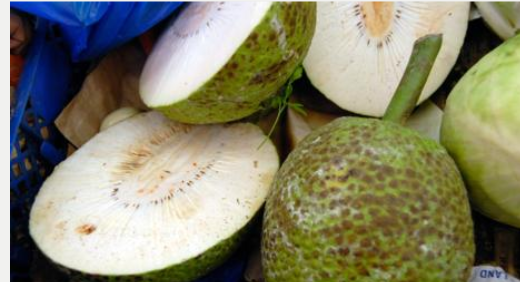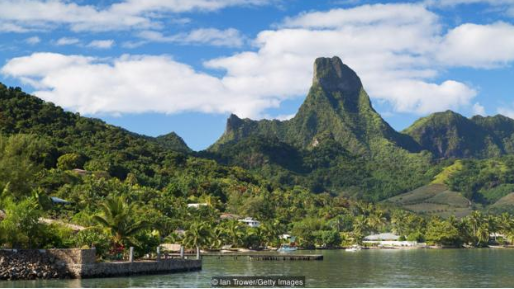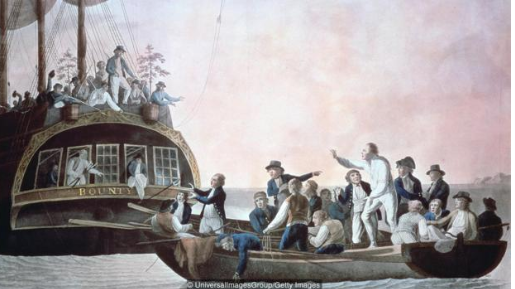
The French Polynesians have a legend about a famine that occurred on the island of Ra'iātea. A family of six were so desperate for food that they went to live in a cave and ate wild ferns that grew in the surrounding valley. The family patriarch couldn't bear to watch his loved ones suffer, so he told his wife that he was going to bury himself beyond the cave. There, he would blossom into a tree that could feed them. When his wife awoke one morning to find him missing, she knew exactly what had happened. For nearby stood a fast-growing uru tree, its branches bearing loads of breadfruit. Today, this place is called Mahina, but many locals still refer to it as Tua-uru, which means ‘valley of the breadfruit’.
You may also be interested in:
• The soup that united a country
• Where afternoon tea really came from
• The island that forever changed science
On my visit to French Polynesia, I didn't need a story to deduce that breadfruit, or uru, as local Polynesians call it, is a prominent part of both the islanders' diet and their culture. Everywhere I went, I saw the towering trees with their waxy leaves and heavy-hanging fruits, each the size of softballs or larger. They decorated roadsides and the yards of low-slung homes (“A common thing,” a native Polynesian named Tea told me, “because it means you can feed your family for many years”). At market stalls, the circular and oblong-shaped breadfruit (there are dozens of varieties in French Polynesia alone) lay alongside coconuts, plantains, soursops and passionfruit, their green exterior covered in tiny hexagonal shapes. Some were cut in half, exposing a fibrous white flesh. They resembled jackfruit, though smaller, and it turns out that they're part of the same family, along with figs.
The breadfruit, or uru, is a significant part of the diet and culture of French Polynesia (Credit: Credit: Photofusion/Getty Images)
The breadfruit, or uru, is a significant part of the diet and culture of French Polynesia (Credit: Photofusion/Getty Images)
On the more than 100 islands that make up French Polynesia, breadfruit is a staple food. The name derives from the fact that when it’s just ripe enough to eat, the cooked, starch-heavy fruit resembles freshly baked bread. It gets sweeter as it ripens, and can be prepared in a multitude of ways, including mashed, boiled, roasted and fried, or even devoured raw. Some locals call breadfruit the ‘Tree of Life’, because it can provide so much for so many: both the fruit and the tree's young leaves are edible; the trunk's lightweight timber can be used to build homes and traditional outrigger canoes; and the bark is even used to make clothes.
Experts say it’s a superfood of the future that has the potential to solve world hunger
Uru, it turns out, is no secret. Native to greater New Guinea, Polynesians have been carrying and cultivating breadfruit on their explorations through the South Pacific for thousands of years. Once British explorers caught wind of the high-yielding plant and its nutritious fruit, it was only a matter of time before uru would end up around the world. Today, breadfruit trees abound in the tropical lowlands of 90 or so countries, including Malaysia, where it's called buah sukun, Venezuela (pan de año) and India (kadachakka).
In 1768, when Captain James Cook set out aboard the British Royal Navy vessel HMS Endeavour, English botanist Sir Joseph Banks in tow, their three-year exploratory voyage included a three-month stop in Tahiti. Here, both men were quickly taken by breadfruit's potential for feeding slaves in the British West Indies, seeing that the trees were fast-growing, required little care and produced ample amounts of carb-heavy fruits. On returning to England, Banks (who later became president of the Royal Society, the world's oldest national scientific institution) alerted King George III of their finds; the botanist even offered a reward to anyone successful in transporting 1,000 breadfruit plants from Tahiti to the West Indies.
In the 1700s, Captain James Cook and botanist Sir Joseph Banks travelled to Tahiti where they discovered the breadfruit (Credit: Credit: Ian Trower/Getty Images)
In the late 1700s, Captain James Cook and botanist Sir Joseph Banks spent three months in Tahiti where they discovered the breadfruit (Credit: Ian Trower/Getty Images)
I soon found myself on a little breadfruit expedition of my own. At Tropical Garden, a family-owned farm filled with tropical flowers and fruit trees on the island of Mo'orea, I feasted on a square of sweet, steamed breadfruit soaked in tapioca known as po'e (Tahitian fruit pudding). From the moment I tasted its rich, custardy flavour I was sold. Everywhere I went I scoured menus for breadfruit treats like fritters, salads and ice cream. I read about it cooked over fire, saturated in fermented coconut milk and eaten warm with punu pua'atoro, or canned corned beef, and ground into flour to make gluten-free bread. Some plant experts even say it’s a superfood of the future that has the potential to solve world hunger. I asked myself, how did such a substantial fruit – and one, I would soon find, with an intriguing pedigree – stay under my radar for so long?
Nearly two decades after Cook's original expedition, King George III appointed Lieutenant William Bligh to lead the breadfruit expedition to Tahiti. On 28 November 1787, Bligh set sail with his crew aboard the HMS Bounty. Their journey was rough from the start. High winds and stormy weather significantly slowed their voyage, and once they reached Tahiti, Bligh and his crew had to wait another five months for the plants to be ready to transport.
By the time they set sail for Caribbean waters, Bligh's men had grown used to island living – and to the Tahitian women. Many of them didn't want to leave. So, on 29 April 1789, just a month into their voyage across the South Pacific towards the West Indies, Master's mate Fletcher Christian and 18 other disaffected crew members forced Bligh, with 18 of his supporters, into a 7m longboat and dispatched them into the open waters, tossing all the breadfruit plants overboard and sailing off on their own.
The ‘Mutiny on the Bounty’ occurred while Lieutenant William Bligh was transporting breadfruit from Tahiti to the Caribbean

(Credit: Credit: UniversalImagesGroup/Getty Images)
The infamous ‘Mutiny on the Bounty’ occurred while Lieutenant William Bligh was transporting breadfruit from Tahiti to the Caribbean

(Credit: UniversalImagesGroup/Getty Images)
The ‘Mutiny on the Bounty’ is now the stuff of legends, and most historians believe that it happened because those siding with Christian thought he could help them return to Tahiti – something that although eventually did happen, didn't quite go as planned. Bligh and his crew surprisingly survived, making their way by instinct and memory a total of 3,618 nautical miles (6,701km) over 48 days to Timor, an island in maritime Southeast Asia. Bligh soon returned to England, where he was honourably acquitted of any misconduct, and, two years later, set out once again for Tahiti, this time successfully completing his mission. In fact, some of those original trees Bligh delivered are rumoured to be still producing fruit in Jamaica.
This is a fruit worthy of some legendary history
On the final day of my trip I found myself at Papeete Market, a massive, buzzing marketplace just a few blocks from the bay in Tahiti. While other travellers perused the countless stalls selling colourfully printed pareos, a type of sarong, bottles of monoï (a mix of coconut oil and flowers) and vanilla oils, and fragrant gardenia hair adornments, I headed upstairs to Cafe Maeva to try the one breadfruit dish that had eluded me so far: frites de uru, or deep-fried, thick-cut breadfruit chips. Each bite into one of those crisp skins to taste the warm, pulpy interior told me straight-up: this is a fruit worthy of some legendary history.
Source: bbc news
Hi! I am a robot. I just upvoted you! I found similar content that readers might be interested in:
http://www.bbc.com/travel/story/20180517-the-island-fruit-that-caused-a-mutiny